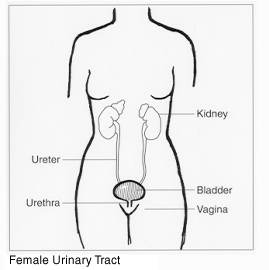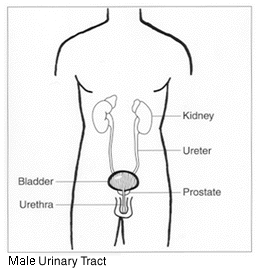bladder cancer


Bladder cancer is cancer that forms in tissues of the bladder (the organ that stores urine). Most bladder cancers are transitional cell carcinomas (cancer that begins in cells that normally make up the inner lining of the bladder). Other types include squamous cell carcinoma (cancer that begins in thin, flat cells) and adenocarcinoma (cancer that begins in cells that make and release mucus and other fluids). The cells that form squamous cell carcinoma and adenocarcinoma develop in the inner lining of the bladder as a result of chronic irritation and inflammation.
The bladder
The bladder is a hollow organ in the lower abdomen. It stores urine, the liquid waste produced by the kidneys. Urine passes from each kidney into the bladder through a tube called a ureter.
An outer layer of muscle surrounds the inner lining of the bladder. When the bladder is full, the muscles in the bladder wall can tighten to allow urination. Urine leaves the bladder through another tube, the urethra.
Who is at risk from bladder cancer?
No one knows the exact causes of bladder cancer. However, it is clear that this disease is not contagious. No one can "catch" cancer from another person.
People who get bladder cancer are more likely than other people to have certain risk factors. A risk factor is something that increases a person's chance of developing the disease.
Still, most people with known risk factors do not get bladder cancer, and many who do get this disease have none of these factors. Doctors can seldom explain why one person gets this cancer and another does not.
Studies have found the following risk factors for bladder cancer:
Chlorine is added to water to make it safe to drink. It kills deadly bacteria. However, chlorine by-products sometimes can form in chlorinated water. Researchers have been studying chlorine by-products for more than 25 years. So far, there is no proof that chlorinated water causes bladder cancer in people. Studies continue to look at this question.
Some studies have found that saccharin, an artificial sweetener, causes bladder cancer in animals. However, research does not show that saccharin causes cancer in people.
People who think they may be at risk for bladder cancer should discuss this
concern with their doctor. The doctor may suggest ways to reduce the risk
and can plan an appropriate schedule for checkups.
Signs and symptoms
Common symptoms of bladder cancer include:
These symptoms are not sure signs of bladder cancer. Infections, benign tumors, bladder stones, or other problems also can cause these symptoms. Anyone with these symptoms should see a doctor so that the doctor can diagnose and treat any problem as early as possible. People with symptoms like these may see their family doctor or a urologist, a doctor who specializes in diseases of the urinary system.
Diagnosis
If a patient has symptoms that suggest bladder cancer, the doctor may check general signs of health and may order lab tests. The person may have one or more of the following procedures:
The doctor can remove samples of tissue with the cystoscope. A pathologist then examines the tissue under a microscope. The removal of tissue to look for cancer cells is called a biopsy. In many cases, a biopsy is the only sure way to tell whether cancer is present. For a small number of patients, the doctor removes the entire cancerous area during the biopsy. For these patients, bladder cancer is diagnosed and treated in a single procedure.
A patient who needs a biopsy may want to ask the doctor some of the following questions:
Staging the disease
If bladder cancer is diagnosed, the doctor needs to know the stage, or extent, of the disease to plan the best treatment. Staging is a careful attempt to find out whether the cancer has invaded the bladder wall, whether the disease has spread, and if so, to what parts of the body.
The doctor may determine the stage of bladder cancer at the time of diagnosis, or may need to give the patient more tests. Such tests may include imaging tests – CT scan, magnetic resonance imaging (MRI), sonogram, intravenous pyelogram, bone scan, or chest X-ray. Sometimes staging is not complete until the patient has surgery.
These are the main features of each stage of the disease:


